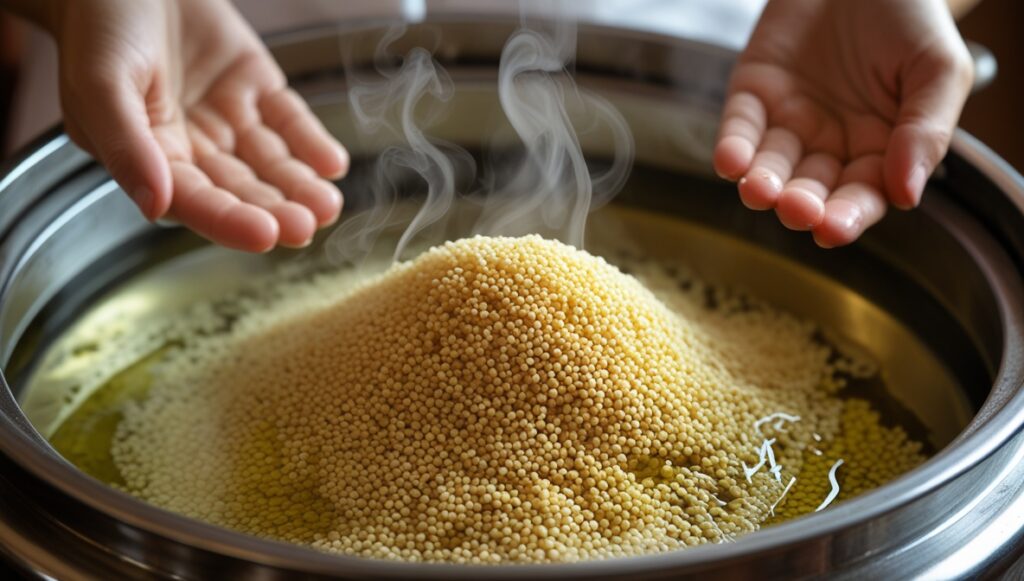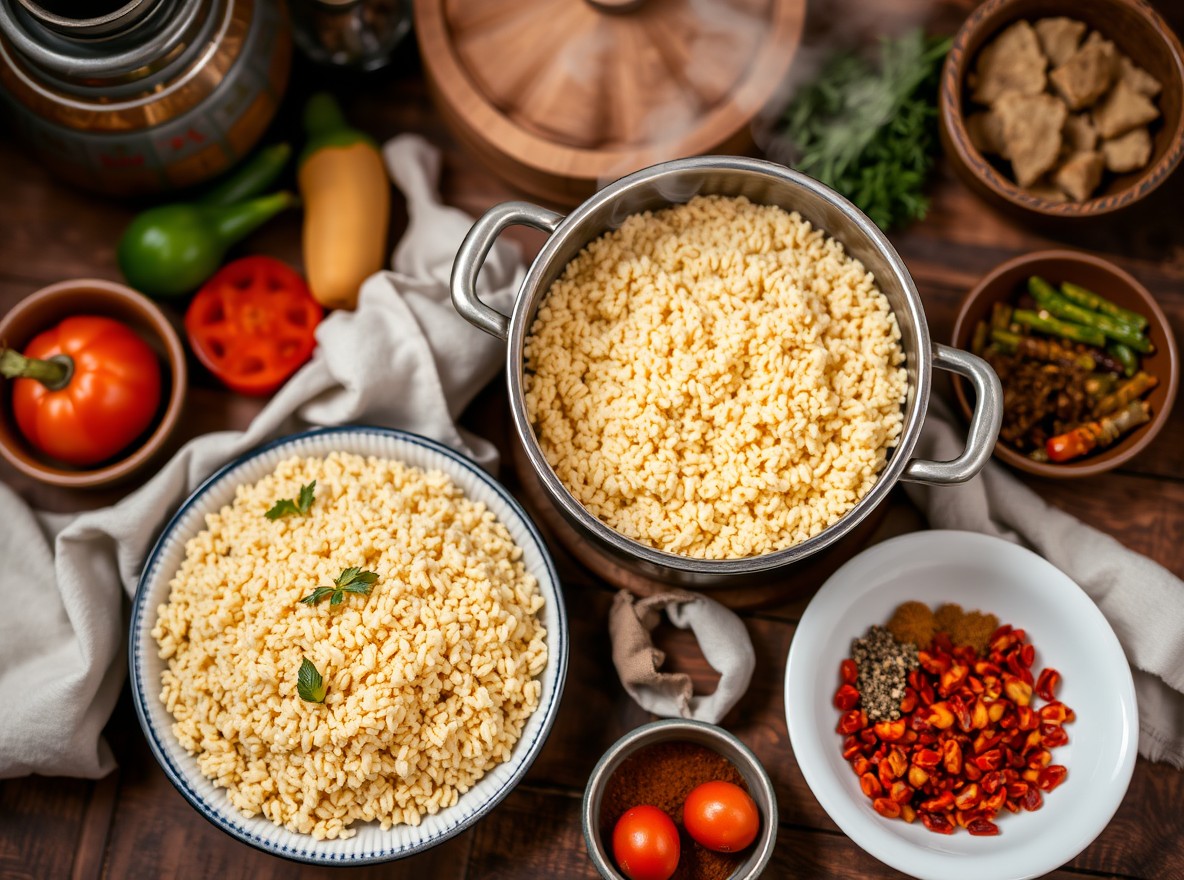Introduction
Traditional Moroccan food is deeply rooted in culture, and one of its most cherished dishes is this beloved grain. Recognized as Morocco’s national dish, it symbolizes heritage and hospitality. Couscous Often served on Fridays for communal meals, this light and fluffy semolina-based dish pairs beautifully with meats, vegetables, and aromatic spices. But what makes it truly special? Let’s explore its history, cultural significance, and how to enjoy this staple of Moroccan cuisine like a local.


History & Cultural Significance
Authentic Moroccan dishes have been shaped by centuries of tradition, and this dish has origins tracing back over 1,000 years to Berber civilizations in North Africa. It was originally prepared using hand-rolled semolina wheat and steamed in a special pot known as a couscoussier.
This dish transcended class distinctions, appearing in medieval Arab cookbooks and spreading to Andalusian Spain and the Middle East via trade routes. Today, it remains an essential part of Moroccan cuisine, playing a key role in Friday family gatherings, religious celebrations, and weddings.
Ingredients & Regional Variations
Key Ingredients:
Semolina wheat (or alternatives like barley or corn in some areas)
Meat (lamb, chicken, or beef)
Vegetables (carrots, zucchini, chickpeas, turnips, etc.)
Spices (cinnamon, saffron, cumin, turmeric)
Dried fruits (raisins, apricots, almonds) – optional for a sweeter touch
Regional Variations in Morocco:
Tfaya Style – A sweet version featuring caramelized onions, raisins, cinnamon, and almonds.
Bidaoui Style – The traditional Casablanca-style variety with seven vegetables.
Berber Style – Made using barley, typically served with lamb and root vegetables.
Seafood Style – A coastal specialty from Essaouira, prepared with fish and shellfish.
Cooking Process & Difficulty Level

This dish may look simple, but traditional preparation takes time and patience. The authentic Moroccan method involves steaming the grains three times in a couscoussier, which makes them incredibly light and fluffy.
Step-by-Step Brief Cooking Guide:
- Prepare the grains – Sprinkle water over dry semolina, fluff with fingers, and let it absorb moisture.
- Steam in a couscoussier – Place it in the top chamber, allowing steam from the stew below to cook it gradually.
- Cook the stew – Sauté onions, add meat, vegetables, spices, and broth, and let it simmer until tender.
- Final steam & serve – Fluff the grains again, steam one last time, and serve with stew on top.
Difficulty Level: Beginner-friendly (for instant versions) / Advanced (for traditional steamed method)
Where to Eat Couscous in Morocco
For an authentic taste, check out these famous places:
Dar Moha (Marrakech) – A Michelin-starred experience with gourmet preparations.
Café Clock (Fes) – A cozy spot with unique takes on traditional dishes.
La Maison Arabe (Marrakech) – Renowned for its Friday feasts.
Chez Lamine Hadj Mustapha (Marrakech) – A hidden gem for authentic Moroccan flavors.
Pairing with Drinks & Side Dishes
Best Drinks to Accompany This Dish:
Moroccan Mint Tea
– The classic pairing!
Red Moroccan Wine
– Pairs well with lamb.
Fresh Orange Juice
– A refreshing option.
Perfect Side Dishes:
Harira Soup – A traditional Moroccan tomato and lentil soup.
Zaalouk – A smoky eggplant and tomato dip.
Khubz (Moroccan Bread) – Great for soaking up the flavors.
Fun Facts & Lesser-Known Trivia
- In Morocco, this dish is traditionally eaten by hand, with families gathered around one large communal plate.
- UNESCO recognized it as an Intangible Cultural Heritage of Humanity in 2020!
- The largest version ever made weighed over 6,000 kg in Algeria.
Health Benefits & Nutrition
- Rich in fiber – Helps digestion.
- Low in fat – A great alternative to pasta.
- Protein-packed – Especially when combined with chickpeas and meat.
- Gluten-Free Versions Available – Some Moroccan variations use corn or millet.
How to Cook It at Home (Best Couscous Recipe)
Ingredients:
2 cups instant semolina grains
2 cups chicken or vegetable broth
1 tbsp olive oil
½ tsp salt
1 tsp cumin
1 tsp turmeric
1 cup chickpeas (optional)
½ cup raisins or almonds (optional)
Method:
- Heat the broth in a pot until it simmers.
- Add olive oil, salt, and spices.
- Remove from heat, stir in grains, and cover for 5 minutes.
- Fluff with a fork and mix in chickpeas, raisins, or almonds.
- Serve warm with stew or vegetables.
Cooking Tip: Use a fork to separate the grains to keep them light and fluffy!
Global Influence & Fusion Cuisine
This dish has spread worldwide, with countries adapting it into their cuisines.


Comparison with Similar Dishes
Vs. Quinoa – Both are light grains, but quinoa is a complete protein.
Vs. Rice – Absorbs flavors more quickly and has a fluffier texture.
Vs. Bulgur – Bulgur is coarser and nuttier in taste.

